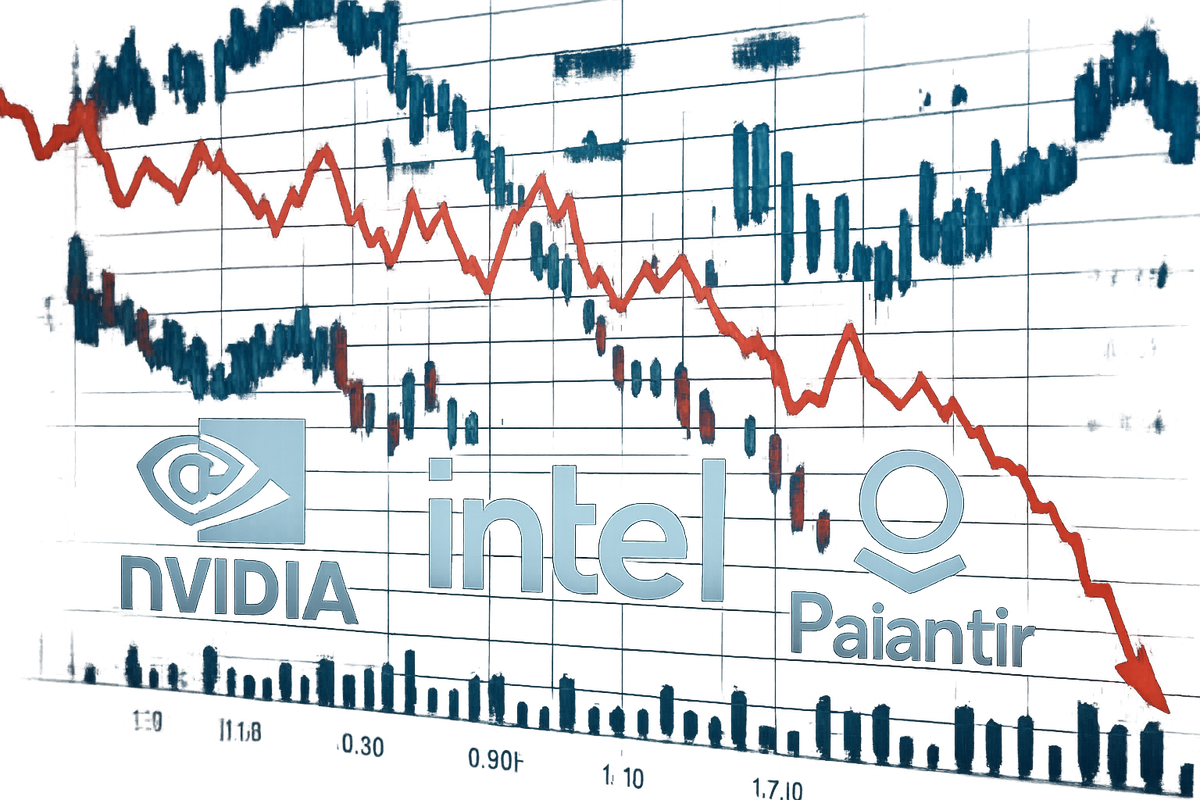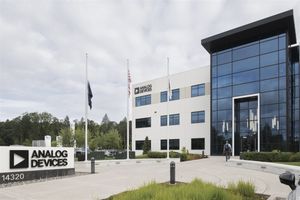
The technology sector has recently experienced a significant market correction, with bellwether AI-related stocks like Nvidia (NASDAQ: NVDA), Palantir Technologies (NYSE: PLTR), and Intel (NASDAQ: INTC) feeling the brunt of investor skepticism and profit-taking. This downturn, particularly pronounced in mid-August 2025, has seen a re-evaluation of the high-flying artificial intelligence sector, raising questions about valuations and the immediate returns on AI investments. The sell-off signals a broader shift in market sentiment, prompting a closer look at the resilience of these AI giants amidst a more cautious investment landscape.
This period of market volatility is not merely a blip but a critical moment for the AI industry, as investors grapple with the rapid pace of innovation versus tangible financial returns. The performance of these key players will serve as a barometer for the broader health and future trajectory of the AI market, influencing investment strategies and corporate development in the months to come.
The AI Sector's Reality Check: What Happened and Why It Matters
The recent tech sell-off, particularly on August 19th and 20th, 2025, saw the Nasdaq Composite slide by 1.46% and the S&P 500 fall by 0.59%, marking a significant pullback from earlier highs. This correction was driven by a confluence of factors, including widespread profit-taking after an extended tech rally, growing concerns about overvaluation, and increasing skepticism surrounding the artificial intelligence sector. A pivotal moment arrived with OpenAI CEO Sam Altman's candid remark that "AI is in a bubble," drawing parallels to the dot-com bust and fueling fears of stretched valuations.
Further exacerbating these concerns was a damning report from the Massachusetts Institute of Technology (MIT) titled "The Generative AI Chasm: The State of Business AI in 2025." The report revealed that a staggering 95% of companies investing in generative AI had seen "zero returns" on their investments, attributing these failures to internal "learning gaps" and flawed integration strategies rather than the inherent quality of AI models. This finding significantly dampened market optimism, prompting a re-evaluation of the immediate profitability and practical application of AI technologies.
Adding to the market's caution was the anticipation of Federal Reserve Chair Jerome Powell's speech at the Jackson Hole Symposium, where investors sought clues regarding future monetary policy and potential interest rate cuts. Geopolitical tensions, particularly concerns over increased U.S. government intervention in the semiconductor industry—including potential equity stakes in chipmakers via CHIPS Act incentives and revenue-sharing deals with companies like Nvidia—also weighed heavily on sentiment. Moreover, inflationary pressures highlighted by earnings reports from major retailers suggested potential impacts on consumer spending, contributing to a broader pullback from growth stocks and a rotation into more traditional value investments.
Winners and Losers in the AI Correction
The tech sell-off created a clear divide between companies that weathered the storm and those that faced significant headwinds. The AI sector, in particular, saw pronounced movements among its leading players.
Nvidia (NASDAQ: NVDA), a bellwether for the AI and tech sector, experienced a significant decline, plummeting 3.5% on August 19th, its largest single-day loss since April. As one of the weakest performers among the "Magnificent Seven" stocks, Nvidia's downturn was influenced by broader market concerns, geopolitical tensions regarding China export licenses, and uncertainty surrounding its upcoming Q2 earnings report. Despite the immediate losses, some analysts view this sell-off as a potential buying opportunity, maintaining confidence in the long-term growth of the AI sector and looking to Nvidia's earnings report on August 27th as a potential positive catalyst. The company's dominant position in AI chip manufacturing means its long-term prospects remain tied to the fundamental growth of AI adoption, even if short-term market sentiment is volatile.
Palantir Technologies (NYSE: PLTR) was among the hardest hit, sinking 9% on August 19th, marking its fifth consecutive day of decline and making it the S&P 500's worst performer. This slump continued into August 20th. The significant drop was largely triggered by Citron Research, a prominent short-seller, which called Palantir's valuation "super disconnected from fundamentals" and suggested a target price of $40. Inflation concerns and the MIT report on AI investment returns further contributed to its pullback. Despite these recent losses, Palantir's stock had more than doubled in value in 2025, up 93% year-to-date, driven by strong demand for its Artificial Intelligence Platform and government contracts. The recent correction tests the sustainability of its rapid growth and the market's willingness to pay a premium for its AI-driven data analytics solutions.
Intel (NASDAQ: INTC) presented a mixed picture during the sell-off. On August 19th, it surged 7% following news of a $2 billion investment from SoftBank, demonstrating that company-specific catalysts can, at times, counter broader market trends. However, this boost proved temporary, as Intel dropped 7% on August 20th, becoming one of the S&P 500's biggest decliners. The stock's movement has also been influenced by speculation about potential backing from the Trump administration and government equity stakes tied to CHIPS Act incentives, with some analysts suggesting its recent rally was more politically driven than fundamentally sound. Intel's efforts to regain its footing in the semiconductor manufacturing space, particularly in advanced chip production, are closely tied to government support and its ability to compete with industry leaders like Taiwan Semiconductor Manufacturing Company (NYSE: TSM) and Nvidia.
Industry Impact and Broader Implications
The recent tech sell-off and the specific struggles of AI giants like Nvidia, Palantir, and Intel underscore a critical juncture for the artificial intelligence industry. This event fits into a broader trend of market re-evaluation, where the initial euphoria surrounding AI's potential is now being tempered by a demand for tangible returns and sustainable business models. The "AI bubble" fears, amplified by Sam Altman's comments and the MIT report, suggest that the market is moving beyond speculative investments to a more discerning approach, scrutinizing the actual implementation and profitability of AI solutions.
The ripple effects of this correction are likely to be felt across the entire technology ecosystem. Competitors and partners of these AI leaders will face increased pressure to demonstrate clear value propositions and robust financial performance. Smaller AI startups, particularly those reliant on venture capital, may find fundraising more challenging as investors become more risk-averse and demand clearer paths to profitability. This could lead to consolidation within the industry, with stronger, more established players potentially acquiring struggling startups.
Regulatory and policy implications are also coming to the forefront. The discussion around U.S. government intervention in the semiconductor industry, including potential equity stakes and revenue-sharing deals via CHIPS Act incentives, highlights a growing recognition of AI's strategic importance and the desire to secure domestic supply chains. Such interventions could reshape the competitive landscape, favoring companies that align with national strategic objectives. Historically, periods of rapid technological advancement followed by market corrections are not uncommon. The dot-com bubble of the late 1990s serves as a stark reminder that even revolutionary technologies can experience irrational exuberance before a more realistic assessment of their long-term value. This current correction could be seen as a necessary cleansing, separating genuinely transformative AI applications from overhyped ventures.
What Comes Next
The immediate aftermath of this tech sell-off will likely see continued volatility as the market digests the implications of the MIT report and awaits further economic data and corporate earnings. In the short term, investors will be closely watching Nvidia's Q2 earnings report on August 27th, which could serve as a significant catalyst for the broader AI sector. A strong performance from Nvidia, particularly in its data center and AI segments, could help restore some confidence, while any weakness might prolong the current downturn.
In the long term, this market correction could force strategic pivots and adaptations across the AI industry. Companies will need to focus more intently on demonstrating clear return on investment (ROI) for their AI solutions, moving beyond proof-of-concept projects to scalable, revenue-generating applications. This might involve a greater emphasis on industry-specific AI solutions, deeper integration with existing enterprise systems, and a clearer articulation of how AI drives efficiency, cost savings, or new revenue streams.
Market opportunities may emerge for companies that can effectively address the "learning gaps" and integration challenges highlighted by the MIT report. Consulting firms specializing in AI implementation, data governance, and change management could see increased demand. Furthermore, the correction might present buying opportunities for long-term investors who believe in the fundamental transformative power of AI but are seeking more attractive entry points. Potential scenarios include a prolonged period of consolidation and more modest growth for the AI sector, or a rebound driven by strong earnings from key players and a clearer demonstration of AI's practical value. The outcome will largely depend on how quickly companies can translate AI innovation into tangible business results and how effectively they can communicate that value to investors.
Conclusion
The recent tech sell-off, particularly impacting AI giants like Nvidia, Intel, and Palantir, represents a significant recalibration of market expectations for the artificial intelligence sector. The key takeaway is a shift from speculative enthusiasm to a demand for demonstrable returns and sustainable business models. While the immediate impact has been a decline in stock valuations and heightened investor caution, this period of correction could ultimately strengthen the AI industry by weeding out less viable ventures and forcing a greater focus on practical, value-driven applications.
Moving forward, the market will be closely scrutinizing corporate earnings, particularly from companies at the forefront of AI development. Investors should watch for clear evidence of AI solutions driving revenue growth, improving operational efficiency, and delivering measurable ROI. The emphasis will be on fundamental strength rather than just growth potential. Furthermore, developments in regulatory policy, especially regarding government support for the semiconductor industry, will play a crucial role in shaping the competitive landscape.
The lasting impact of this correction will likely be a more mature and disciplined AI market. While the "AI bubble" fears have prompted a necessary reality check, the underlying technological advancements and the long-term potential of AI remain undeniable. Investors should focus on companies with strong fundamentals, clear business strategies, and a proven ability to integrate AI effectively to solve real-world problems. The coming months will be critical in determining whether this correction is a temporary setback or a fundamental re-shaping of the AI investment landscape.





